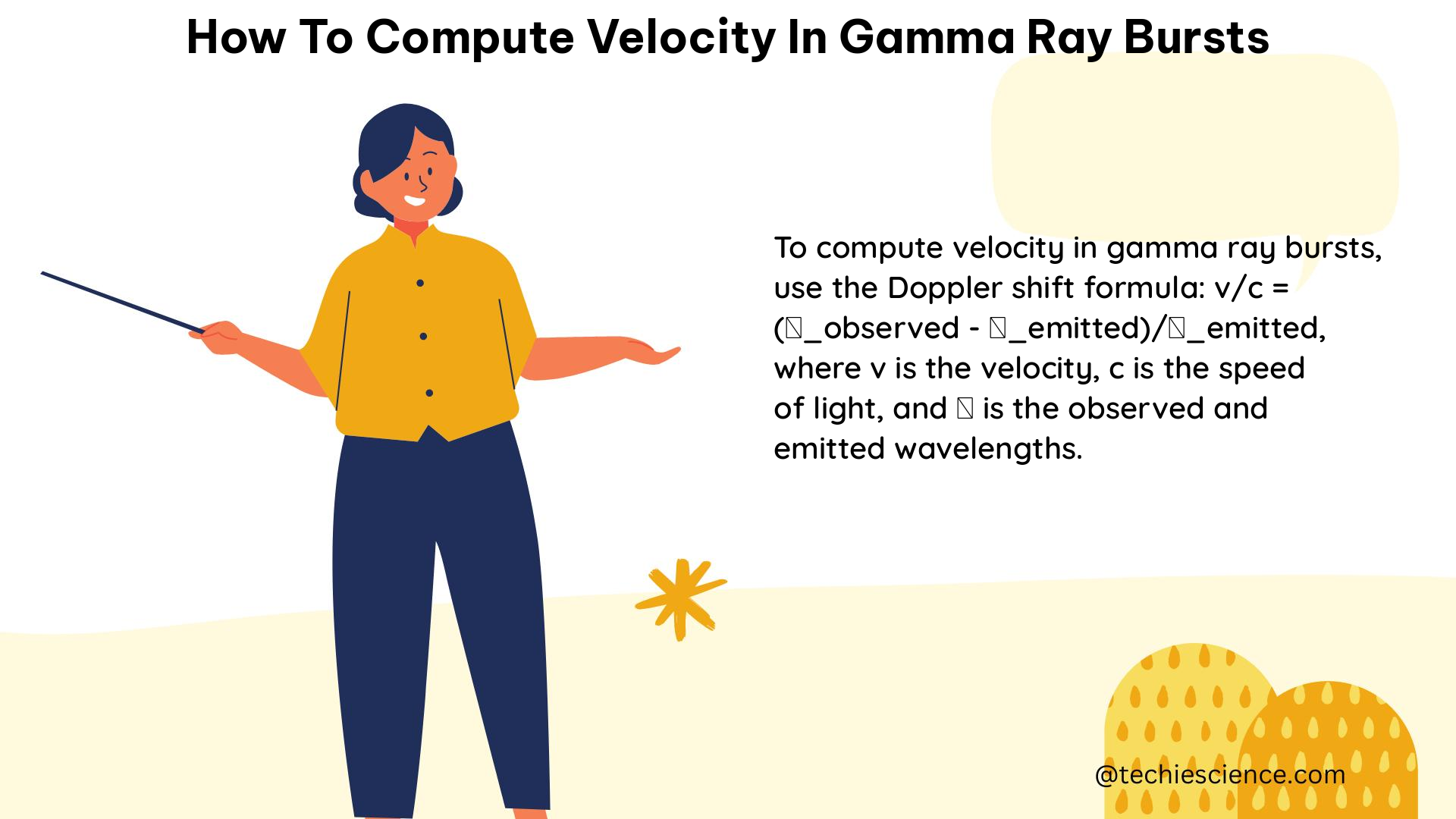Gamma-ray bursts (GRBs) are the most energetic explosions in the universe, releasing an enormous amount of energy in the form of high-energy electromagnetic radiation. To understand the physics behind these cosmic events, astronomers need to accurately measure the velocity of the emitting material. This comprehensive guide will walk you through the step-by-step process of computing the velocity in GRBs.
Measuring Redshift and Velocity using the Doppler Effect
The primary method for computing the velocity in GRBs is based on the Doppler effect. The Doppler effect describes how the frequency of a wave changes depending on the relative speed of the source and the observer. In the context of GRBs, the Doppler effect is used to measure the redshift (z) of the spectral lines, which is related to the velocity (v) of the object through the equation:
v = cz
where c is the speed of light.
To measure the redshift of a GRB, astronomers analyze the spectrum of the burst and identify the characteristic spectral lines. The shift in the wavelength of these lines compared to their rest-frame wavelengths is the redshift (z). Once the redshift is known, the velocity can be calculated using the Doppler effect equation.
Estimating the Bulk Lorentz Factor (Γ₀)

In addition to the velocity, another important parameter in GRB physics is the bulk Lorentz factor (Γ₀), which describes the relativistic motion of the emitting material. The Lorentz factor is related to the velocity through the equation:
Γ₀ = 1 / √(1 - v²/c²)
where v is the velocity of the emitting material and c is the speed of light.
Ghirlanda et al. (2012) estimated the bulk Lorentz factor (Γ₀) of 31 GRBs using the measured peak time of their afterglow light curves. They considered two possible scenarios for the estimate of Γ₀: a homogeneous circumburst medium or a wind density profile. The values of Γ₀ were found to be broadly distributed between a few tens and several hundreds, with average values of ∼138 and ∼66 for the homogeneous and wind density profile, respectively.
Correlations between Γ₀, Eiso, Liso, and Epeak
The study by Ghirlanda et al. (2012) also revealed several important correlations involving the bulk Lorentz factor (Γ₀):
- Isotropic Energy (Eiso) and Luminosity (Liso) Correlation with Γ₀: The isotropic energy (Eiso) and luminosity (Liso) of GRBs were found to correlate with the bulk Lorentz factor (Γ₀).
- Peak Energy (Epeak) Correlation with Γ₀: The peak energy (Epeak) of the GRB spectrum was found to be proportional to the bulk Lorentz factor (Γ₀).
- Epeak–Eiso and Epeak–Liso Correlations: The Epeak–Eiso and Epeak–Liso correlations are due to the different Γ₀ factors.
- Epeak–Eγ Correlation: The collimation-corrected correlation, Epeak–Eγ (obtained by correcting the isotropic quantities for the jet opening angle θj), can be explained if θjΓ₀ = constant.
These correlations offer a general interpretation scheme for the spectral energy correlation of GRBs and provide insights into the underlying physics of these cosmic events.
Physics Examples and Numerical Problems
Here are some examples and numerical problems related to computing the velocity and Lorentz factor in GRBs:
Examples:
1. Measuring the redshift of a GRB using its spectrum
2. Estimating the distance to a GRB using Hubble’s Law and its redshift
3. Calculating the bulk Lorentz factor (Γ₀) of a GRB using its afterglow light curve
Numerical Problems:
1. Given the redshift (z) of a GRB, calculate its velocity (v) using the Doppler effect equation.
2. Given the afterglow light curve of a GRB, estimate its bulk Lorentz factor (Γ₀) using the formula provided.
3. Given the isotropic energy (Eiso) and luminosity (Liso) of a GRB, calculate its peak energy (Epeak) using the correlations discussed.
By understanding the concepts and applying the equations presented in this guide, you will be able to effectively compute the velocity and other key parameters in gamma-ray bursts, which is essential for advancing our knowledge of these fascinating cosmic phenomena.
References
- Ghirlanda, G., Nava, L., Ghisellini, G., Celotti, A., Burlon, D., Covino, S., & Melandri, A. (2012). Gamma-ray bursts in the comoving frame. Monthly Notices of the Royal Astronomical Society, 420(1), 483-494.
- An Information & Activity Booklet: Gamma-Ray Bursts. (n.d.). Retrieved from https://cmase.uark.edu/_resources/pdf/gems/gamma_ray_bursts_9-12.pdf
- Gamma-Ray Bursts – Answers. (n.d.). Retrieved from https://imagine.gsfc.nasa.gov/educators/gammaraybursts/imagine/page28.html
- How Far? How Powerful? – Imagine the Universe! – NASA. (2021, October 18). Retrieved from https://imagine.gsfc.nasa.gov/educators/lessons/how_far/

The lambdageeks.com Core SME Team is a group of experienced subject matter experts from diverse scientific and technical fields including Physics, Chemistry, Technology,Electronics & Electrical Engineering, Automotive, Mechanical Engineering. Our team collaborates to create high-quality, well-researched articles on a wide range of science and technology topics for the lambdageeks.com website.
All Our Senior SME are having more than 7 Years of experience in the respective fields . They are either Working Industry Professionals or assocaited With different Universities. Refer Our Authors Page to get to know About our Core SMEs.